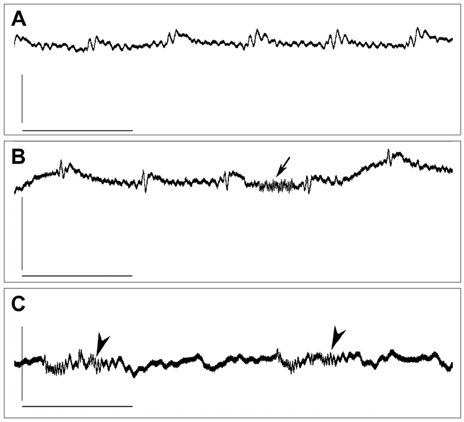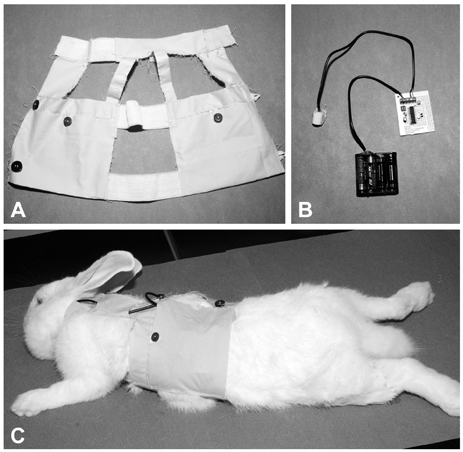J Clin Neurol.
2013 Oct;9(4):269-273. 10.3988/jcn.2013.9.4.269.
Impact of Chronic Simulated Snoring on Carotid Atherosclerosis in Rabbits
- Affiliations
-
- 1Department of Neurology, Boramae Hospital, Seoul National University, Seoul, Korea.
- 2Department of Neurosurgery, Boramae Hospital, Seoul National University, Seoul, Korea. nsyang@brm.co.kr
- 3Department of Pathology, Boramae Hospital, Seoul National University, Seoul, Korea.
- 4Department of Biomedical Engineering, College of Medicine, Seoul National University, Seoul, Korea.
- KMID: 1980547
- DOI: http://doi.org/10.3988/jcn.2013.9.4.269
Abstract
- BACKGROUND AND PURPOSE
Chronic simulated snoring was induced in rabbits to determine the impact of snoring on the development of atherosclerosis.
METHODS
The pressure wave of induced snoring at the carotid bifurcation of rabbits was acquired by gently pressing the airway. This wave was then simulated using custom-made mechanical devices. Twelve rabbits were used in this study, seven of which were assigned to the experimental group and the remaining five formed the control group. All of the rabbits were raised on a 1% high-cholesterol diet. Either working or sham devices were positioned at the ventral center of the neck in each rabbit. At the end of a 2-month observation period, all of the rabbits were sacrificed by perfusion fixation, the carotid arteries harvested, and the carotid atherosclerosis histology reviewed.
RESULTS
All of the rabbits survived to the end of the experimental period. Blood sampling revealed the presence of hypercholesterolemia in both groups, with no significant difference between them. The presence and degree of atherosclerosis did not differ significantly between the groups.
CONCLUSIONS
The findings of this study show the feasibility of making a chronic simulated snoring rabbit model. However, the causative role of snoring in carotid atherosclerosis was not detected in this animal study.
MeSH Terms
Figure
Cited by 1 articles
-
The Utility of Three Screening Questionnaires for Obstructive Sleep Apnea in a Sleep Clinic Setting
Bomi Kim, Eun Mi Lee, Yoo-Sam Chung, Woo-Sung Kim, Sang-Ahm Lee
Yonsei Med J. 2015;56(3):684-690. doi: 10.3349/ymj.2015.56.3.684.
Reference
-
1. Libby P. The pathogenesis, prevention, and treatment of atherosclerosis. In : Fauci AS, Braunwald E, Kasper DL, Hauser SL, Longo DL, Jameson JL, editors. Harrison's Principles of Internal Medicine. 17th ed. New York, NY: McGraw Hill;2008. p. 1501–1509.2. Kim K. Atherosclerosis and carotid disease. Korean Stroke Society. Textbook of Stroke. Seoul: Epublic;2009. p. 103–110.3. Placidi F, Diomedi M, Cupini LM, Bernardi G, Silvestrini M. Impairment of daytime cerebrovascular reactivity in patients with obstructive sleep apnoea syndrome. J Sleep Res. 1998; 7:288–292.
Article4. Silvestrini M, Rizzato B, Placidi F, Baruffaldi R, Bianconi A, Diomedi M. Carotid artery wall thickness in patients with obstructive sleep apnea syndrome. Stroke. 2002; 33:1782–1785.
Article5. Bearpark H, Elliott L, Grunstein R, Cullen S, Schneider H, Althaus W, et al. Snoring and sleep apnea. A population study in Australian men. Am J Respir Crit Care Med. 1995; 151:1459–1465.
Article6. Fitzpatrick MF, Martin K, Fossey E, Shapiro CM, Elton RA, Douglas NJ. Snoring, asthma and sleep disturbance in Britain: a community-based survey. Eur Respir J. 1993; 6:531–535.7. Gislason T, Benediktsdóttir B, Björnsson JK, Kjartansson G, Kjeld M, Kristbjarnarson H. Snoring, hypertension, and the sleep apnea syndrome. An epidemiologic survey of middle-aged women. Chest. 1993; 103:1147–1151.8. Jennum P, Hein HO, Suadicani P, Gyntelberg F. Risk of ischemic heart disease in self-reported snorers. A prospective study of 2,937 men aged 54 to 74 years: the Copenhagen Male Study. Chest. 1995; 108:138–142.
Article9. Jennum P, Sjøl A. Snoring, sleep apnoea and cardiovascular risk factors: the MONICA II Study. Int J Epidemiol. 1993; 22:439–444.
Article10. Martikainen K, Partinen M, Urponen H, Vuori I, Laippala P, Hasan J. Natural evolution of snoring: a 5-year follow-up study. Acta Neurol Scand. 1994; 90:437–442.
Article11. Ohayon MM, Guilleminault C, Priest RG, Caulet M. Snoring and breathing pauses during sleep: telephone interview survey of a United Kingdom population sample. BMJ. 1997; 314:860–863.
Article12. Lee SA, Amis TC, Byth K, Larcos G, Kairaitis K, Robinson TD, et al. Heavy snoring as a cause of carotid artery atherosclerosis. Sleep. 2008; 31:1207–1213.13. Amatoury J, Howitt L, Wheatley JR, Avolio AP, Amis TC. Snoring-related energy transmission to the carotid artery in rabbits. J Appl Physiol (1985). 2006; 100:1547–1553.
Article14. Stary HC, Chandler AB, Dinsmore RE, Fuster V, Glagov S, Insull W Jr, et al. A definition of advanced types of atherosclerotic lesions and a histological classification of atherosclerosis. A report from the Committee on Vascular Lesions of the Council on Arteriosclerosis, American Heart Association. Arterioscler Thromb Vasc Biol. 1995; 15:1512–1531.
Article15. Stary HC, Chandler AB, Dinsmore RE, Fuster V, Glagov S, Insull W Jr, et al. A definition of advanced types of atherosclerotic lesions and a histological classification of atherosclerosis. A report from the Committee on Vascular Lesions of the Council on Arteriosclerosis, American Heart Association. Circulation. 1995; 92:1355–1374.
Article16. Rosenfeld ME, Tsukada T, Gown AM, Ross R. Fatty streak initiation in Watanabe Heritable Hyperlipemic and comparably hypercholesterolemic fat-fed rabbits. Arteriosclerosis. 1987; 7:9–23.
Article17. Cornhill JF, Roach MR. Quantitative method for the evaluation of atherosclerotic lesions. Atherosclerosis. 1974; 20:131–136.
Article18. Cornhill JF, Roach MR. A quantitative study of the localization of atherosclerotic lesions in the rabbit aorta. Atherosclerosis. 1976; 23:489–501.
Article19. Hunt CE, Duncan LA. Hyperlipoproteinaemia and atherosclerosis in rabbits fed low-level cholesterol and lecithin. Br J Exp Pathol. 1985; 66:35–46.20. Kritchevsky D, Tepper SA, Williams DE, Story JA. Experimental atherosclerosis in rabbits fed cholesterol-free diets. Part 7. Interaction of animal or vegetable protein with fiber. Atherosclerosis. 1977; 26:397–403.
Article21. Rogers KA, Karnovsky MJ. A rapid method for the detection of early stages of atherosclerotic lesion formation. Am J Pathol. 1988; 133:451–455.22. West CE, Deuring K, Schutte JB, Terpstra AH. The effect of age on the development of hypercholesterolemia in rabbits fed semipurified diets containing casein. J Nutr. 1982; 112:1287–1295.
Article23. Puig F, Rico F, Almendros I, Montserrat JM, Navajas D, Farre R. Vibration enhances interleukin-8 release in a cell model of snoring-induced airway inflammation. Sleep. 2005; 28:1312–1316.
Article24. Almendros I, Acerbi I, Puig F, Montserrat JM, Navajas D, Farré R. Upper-airway inflammation triggered by vibration in a rat model of snoring. Sleep. 2007; 30:225–227.
Article25. Cho JG, Witting PK, Verma M, Wu BJ, Shanu A, Kairaitis K, et al. Tissue vibration induces carotid artery endothelial dysfunction: a mechanism linking snoring and carotid atherosclerosis? Sleep. 2011; 34:751–757.
Article26. Narayan J, Amatoury J, Cho JG, Verma M, Kairaitis K, Wheatley J, et al. Snoring effects on the baroreflex: an animal model. Respir Physiol Neurobiol. 2012; 180:342–351.
Article
- Full Text Links
- Actions
-
Cited
- CITED
-
- Close
- Share
- Similar articles
-
- Carotid Atherosclerosis as a Marker of Atherosclerosis of the Thoracic Aorta in the Elderly
- Clinical Implications of Snoring
- General principles of carotid Doppler ultrasonography
- Prevalence of Carotid Atherosclerosis in the Elderly
- Relationship Between Carotid and Coronary Atherosclerosis in the Elderly




